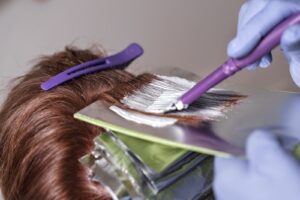Summer is a season of outdoor adventures, beach trips, and basking in the glorious sunshine. However, if you’ve recently undergone a hair transplant or are considering one, it’s essential to take precautions to shield your transplanted hair from the potentially damaging effects of the sun’s rays. In this post, we’ll explore effective strategies to protect your transplanted hair, ensuring its health and longevity during the summer months.
Understanding the Vulnerability of Transplanted Hair to Sun Damage
When you undergo a hair transplant procedure, the transplanted hair follicles are in a critical phase of growth and healing. During this period, the follicles are establishing their blood supply and integrating into the scalp. As a result, they are more vulnerable to external factors. This includes the damaging effects of the sun’s UV radiation.
The sun emits two types of UV radiation: UVA and UVB. UVA rays penetrate the deeper layers of the skin, while UVB rays primarily affect the outer layers. Both types of UV radiation can be harmful to your skin and hair. UVB rays are particularly responsible for sunburns and surface damage.
There are a few reasons transplanted hair is especially susceptible to sun damage:
- Scalp Sensitivity: The scalp, where the transplanted hair follicles reside, is often more sensitive than other parts of the body. The newly transplanted follicles require time to adjust and establish themselves. This makes them more prone to damage from UV radiation.
- Limited Natural Protection: Hair provides some natural protection against the sun’s UV rays. However, transplanted hair is typically shorter and may not provide as much coverage as your natural hair. This exposes the delicate follicles and the scalp to direct sunlight, increasing the risk of damage.
- Healing Process: The healing process of transplanted hair involves the regeneration and integration of the follicles into the scalp. During this phase, the follicles are still establishing their blood supply and becoming fully functional. Exposure to the sun’s harmful rays can impede this process and affect the success of the transplant.
Tips for Protecting Your Transplanted Hair
Transplanted hair needs to be cared for to ensure its health and success. If you’ve had a hair transplant surgery and still want to enjoy the summer weather, there are a few simple things you can do.
Wear a Hat
Wearing a hat is a simple way to protect your transplanted hair. Not only is it an easy addition to your summer wardrobe, but it also provides maximum coverage and protection for your scalp and hair.
Apply Sunscreen to Your Scalp
Applying sunscreen to your scalp is crucial for protecting transplanted hair from harmful UV rays. After undergoing a hair transplant, the newly transplanted follicles are sensitive and require special care. During summer, the scalp is often exposed to direct sunlight, making it susceptible to sunburn and damage. Sunburn not only causes discomfort but can also hinder the healing process and potentially harm the newly transplanted hair follicles. By regularly applying sunscreen with a high SPF to your scalp, you create a protective barrier that shields the delicate follicles from the sun’s harmful rays.
Seek Shade and Limit Sun Exposure
After undergoing a hair transplant procedure, the newly transplanted hair follicles require a delicate healing process to establish themselves in their new location. Sun exposure can be detrimental during this critical phase. Prolonged exposure to the sun’s harmful UV rays can lead to increased scalp sensitivity, inflammation, and potential damage to the transplanted hair. Try to seek shady outdoor spaces when possible and avoid excessive sun exposure.
Hydrate Your Hair
Hydrating your hair is crucial, especially when it comes to protecting transplanted hair. Proper hydration helps maintain the health, strength, and appearance of your newly transplanted follicles. This ensures optimal growth and minimizing the risk of damage. Here are some effective ways to hydrate your hair:
- Conditioners: Regularly using a hydrating conditioner is essential to replenish moisture and nourish your hair. Look for conditioners specifically designed for dry or damaged hair, as they tend to be more hydrating.
- Deep Conditioning Treatments: Treat your hair to deep conditioning treatments at least once a week. These intensive treatments provide deep hydration and repair to your hair, leaving it soft and manageable.
- Leave-In Conditioners: Consider using leave-in conditioners that are formulated to provide long-lasting hydration. These products can be applied after showering or on dry hair to maintain moisture throughout the day.
- Argan Oil or Jojoba Oil: Apply a few drops of argan oil or jojoba oil to the ends of your hair to lock in moisture and prevent dryness. These natural oils are known for their hydrating properties.
- Hydrating Hair Masks: Pamper your hair with hydrating hair masks regularly. These masks are formulated to provide an intense dose of hydration and rejuvenation, leaving your hair revitalized and protected.
By incorporating these hydrating techniques into your hair care routine, you can ensure that your transplanted hair remains healthy, vibrant, and well-nourished.
Avoid Chlorine and Saltwater
If you have recently undergone a hair transplant procedure, try to avoid chlorine and saltwater. Chlorine can be extremely damaging to delicate hair follicles. It strips away natural oils from the scalp, leading to dryness and hair breakage. Similarly, saltwater, especially in high concentrations, can cause hair to become brittle and prone to damage. Steer clear of swimming pools and saltwater bodies during the initial healing phase of your hair transplant to give your hair follicles the best chance of survival and proper growth.
Schedule Regular Check-ups
Scheduling regular check-ups is essential to protect transplanted hair and ensure its long-term success. Here’s why:
- Monitoring Hair Growth: Regular check-ups allow the hair transplant specialist to closely monitor the growth and health of transplanted hair. They can assess the progress, identify any potential issues, and provide timely interventions if necessary.
- Early Detection of Complications: Transplanted hair can be vulnerable to complications such as infections or graft rejection. Regular check-ups enable early detection of any problems, increasing the chances of effective treatment and minimizing the risk of long-term damage.
- Personalized Care: Each individual’s hair transplant journey is unique, and regular check-ups allow for personalized care. The specialist can tailor the follow-up routine based on the specific needs of the patient, ensuring optimal results and addressing any concerns along the way.
Use Hair Products with UV Protection
By incorporating hair products with UV protection into your hair care routine, you provide an extra layer of defense against the damaging effects of the sun. These specialized products create a shield that helps to minimize the penetration of UV rays, preserving the vitality of the transplanted hair and prolonging its lifespan.
In Conclusion
Protecting your transplanted hair from the summer sun is crucial to maintain its health, appearance, and longevity. By following the strategies outlined in this post, you can enjoy the summer while safeguarding your transplanted hair. Working with a reputable Maryland hair transplant specialist like Eldorado can provide you with the personalized care and guidance you need for successful hair restoration.
Contact Eldorado for Baltimore Hair Transplant Services
Take proactive steps to protect your transplanted hair from the summer sun. Schedule a consultation with Eldorado, the leading provider of Baltimore hair transplants and hair restoration. Our expert team is dedicated to helping you achieve healthy, beautiful hair during the summer and throughout the year. Contact us today to learn more and embark on your hair restoration journey.




